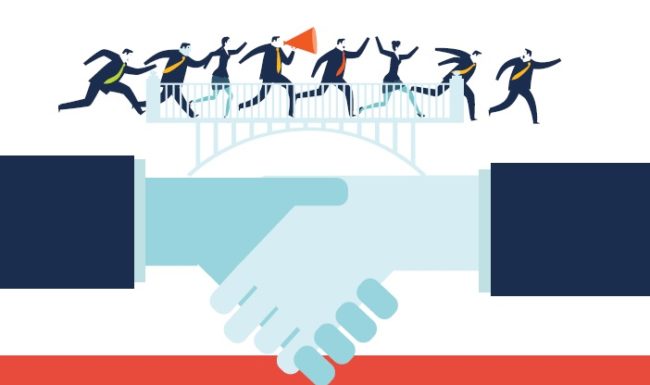How to Create Flag-Waving Customers
The Elusive Art of Converting Customers Into Champions
As we celebrate the Fourth of July, our minds turn to patriotism—that connection between ourselves and our country and all the reasons we are proud to live here and appreciative of what this country provides. It is a strong bond that we will not relinquish easily. In business, we seek to create a similar bond between our customers and our organization, especially when we can forge long-lasting, highly valuable connections.
Think about it: Loyal customers are passionate champions who “wave the flag” for your organization. They make repeat and additional purchases, thereby powering your sales. They also recommend you to others, which reduces your customer acquisition costs. Finally, they’re a font of honest wisdom, helping you enhance product and service offerings, identify unaddressed needs, and remedy performance weaknesses. So, if loyal customers are the goal, the question remains: How do you earn those relationships?
Recognizing a Dynamic Landscape
One of the first steps is to recognize that we live in a time of dramatically changed customer expectations. It used to be that you could build a better mousetrap and the world would beat a path to your door. Nowadays, finding and keeping customers is not so easy. The relationship used to favor businesses, but the pace of innovation and technology has shifted that balance toward consumers. Information about alternative solutions is easier to obtain, and switching costs are low and getting lower—both of which empower customers to demand more of everything to stick with you: more choices, more responsiveness, more personalized attention, more value. If they can get next day—or even same day—delivery, why should they ever wait for anything, least of all, wait for two days or more for a reply to their inquiry? Even more, the sharing economy has further prompted customers to rethink many buying decisions. Why would they own something (a car, a home) when they can use one only when they need it, thanks to companies like Zipcar and Airbnb?
Highly successful companies recognize that the pace of change requires a new, or at least intensified, approach to building customer loyalty. They are obsessed with customers and the customer experience. Amazon’s Jeff Bezos puts it very simply: “We see our customers as invited guests to a party, and we are the hosts. It’s our job every day to make every important aspect of the customer experience a little bit better.” This revolution in the B2C world is having a dramatic impact on B2B environments. According to The Value of Making It Easy, a 2014 study by Walker Information, 88% of companies see their customer expectations affected by their consumer experiences, and 77% of customers say consumer experiences influence B2B expectations. Convenience is king, presenting organizations with both challenges and opportunities about how to differentiate themselves and develop that truly loyal customer base.
It’s All About Them—Being Customer-Centric
Patriotic loyalty does not materialize without a highly intentional effort on the part of business owners and leaders. Every organization has a unique culture, either by definition or default. Making responsiveness to changing customer needs the core of your organization’s culture can truly set you apart in the marketplace. That said, anyone who has ever been involved in a cultural shift knows there is no magic wand or pixie dust solution here. It requires focused leadership attention, continuous reinforcement, and a collective effort by everyone involved to truly “be” customer-centric.
Customer loyalty results from positive customer experience, and that experience is the cumulative impact of every interaction someone has with your organization. Each and every touchpoint before, during, and after a sale is a “moment of truth” when they form an impression of your staff, your products or services, and your overall brand. Talk to your employees and your management team about how your customers FEEL when they interact with you. This, along with how easy you are to work with and the results of your product or service offering, determines the strength of the relationship and, therefore, their loyalty to you.
Cultivating that loyalty requires the unified focus of every employee who interacts with customers in any capacity—as an ongoing source of information and insights and also as the people best positioned to affect customers’ experiences. Fostering employee engagement and clarity about their vital role will help them expand their customer awareness and rapport-building skills, empower them to resolve or escalate matters effectively, and ultimately increase customer engagement.
Seek First to Understand
Because what your customers value evolves over time, the final critical element is to implement regular feedback mechanisms that keep you in tune with their changing priorities. If it’s going to be all about them, you need to keep your finger on their pulse. You may have a lot of resources already in-house that you can use to assemble your dynamic picture: transactional data, financial information, feedback from customer advisory boards, customer surveys, and social media monitoring, to name a few. Your challenge is to make all of those resources accessible for analysis. If you discover there are gaps, you may need to fill them by breaking down internal silos to free information or by collecting supplemental external data. Then examine what you know to uncover compelling behavioral trends, revenue opportunities, and quantifiable event outcomes. The amount of data, per se, is not really what makes it useful; the way it helps you understand how different kinds of customers respond to discrete situations or opportunities is what helps you make better decisions and adjust how you deliver value. One word of advice: You want to be able to drill down to find differences; aggregate data can mask entire market segments that are unhappy and, therefore, obscure revenue that is at risk.
An Ongoing Reason to Celebrate
Creating loyalty is about giving customers reasons to build a durable bond with your organization. That means making a concerted effort to understand their needs, meet and exceed their expectations, and deliver a positive customer experience. It requires top-down leadership to promote an “all-hands” culture in which each employee recognizes his or her role in strengthening customer relationships. In the end, customer loyalty—long-lasting, highly valuable connections—becomes the engine of revenue and profitability growth, and that is definitely something to celebrate!
This article appeared in UBIQUITOUS Issue 5, a magazine on branding, design, and corporate culture. ©RED THINKING, reprinted with permission.
Contributed by Lesley Boucher and Susan Fritsch Cohen of ORI.












